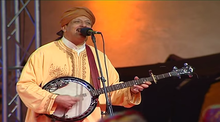Oudaden
ⵓⴷⴰⴷⴻⵏ |
|---|
 Abdellah El Fowa, leader of Oudaden |
|
| Origin | Agadir, Morocco |
|---|
| Genres | Soussi Amazigh |
|---|
| Years active | 1978–present |
|---|
| Labels | Buda Musique |
|---|
|
| Members |
- Abdellah el Foua
- Ahmed el Foua
- Mohammed Jemoumekh
- Larbi Amhal
- Khalid el Foua
- Larbi Boukharmous
|
|---|
Oudaden (in Berber: ⵓⴷⴰⴷⴻⵏ) is a Moroccan musical group that plays Berber amazigh music. The band was formed in 1978 in Ben Sergao near Agadir, in the Sous[1] region of Morocco. Its leader is Abdellah el Foua.
History
Oudaden was founded in 1978 in Ben Sergao [fr], near Agadir. The group has performed throughout Morocco and internationally, particularly in Europe and the United States. They performed in Malaysia at the Rainforest World Music Festival, and in Tanzania on occasion of the Sauti za Busara. Their first album was released in 1985. The band's discography has grown to thirty-eight albums, contributing to the revival of Amazigh song.[2][3][4]
In 2012, they went on tour in France and performed, in particular, at the Arab World Institute.[2][4]
Style
Oudaden takes inspiration from traditional Amazigh music. It is one of the leaders of the Soussi style called "Tagroupit" or "Tiroubba" This new style comes right after the Tazenzart style. This type of music is often present in wedding ceremonies in the Maghreb. and almost always includes at least one banjo and electric guitar; these two instruments constitute the pillars of the "Tiroubba" style.
